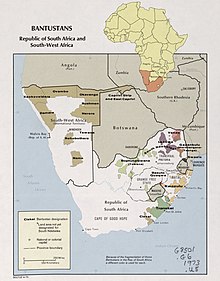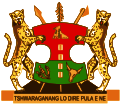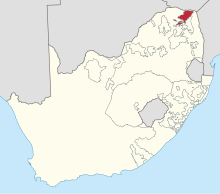


This article lists the leaders of the TBVC states, the four Bantustans which were declared nominally independent by the government of the Republic of South Africa during the period of apartheid, which lasted from 1948 to 1994. Their independence was not recognized outside South Africa.
The bantustans with nominal independence were namely: Transkei (1976),[a][1] Bophuthatswana (1977),[b][2][3] Venda (1979)[c][4] and Ciskei (1981),[d][5] hence the abbreviation TBVC.
The TBVC states were reintegrated into South Africa in the wake of the first post-apartheid general election in April 1994.[6]
| Leader of Transkei | |
|---|---|

Coat of arms of Transkei
| |

Flag of Transkei
| |
Incumbent | |
| Status |
|
| Member of | Military Council (1987–1994) (head of government) |
| Seat | Umtata |
| Term length | No fixed term |
| Formation |
(head of state) |
| First holder |
(head of state) |
| Final holder |
(head of state) |
| Abolished | 26 April 1994; 30 years ago (1994-04-26) |

| No. | Portrait | Name (Birth–Death) |
Term of office | Political affiliation | |||
|---|---|---|---|---|---|---|---|
| Took office | Left office | Time in office | |||||
| Presidents | |||||||
| 1 | 
|
Botha Sigcau (died 1978) |
26 October 1976 | 1 December 1978 †[7] | 2 years, 36 days | TNIP | |
| – | 
|
Zwelibanzi Maneli Mabandla (1906–?) Acting |
1 December 1978 | 20 February 1979 | 81 days | TNIP | |
| 2 | 
|
Kaiser Matanzima (1915–2003) |
20 February 1979[8] | 20 February 1986 (retired) |
7 years | TNIP | |
| 3 | 
|
Tutor Ndamase (1921–1997) |
20 February 1986 | 26 April 1994 | 8 years, 66 days | TNIP | |
| Independent | |||||||
| No. | Portrait | Name (Birth–Death) |
Term of office | Political affiliation | |||
|---|---|---|---|---|---|---|---|
| Took office | Left office | Time in office | |||||
| Chief Minister | |||||||
| 1 | 
|
Kaiser Matanzima (1915–2003) |
6 December 1963 | 26 October 1976 | 12 years, 325 days | TNIP | |
| Prime Ministers | |||||||
| (1) | 
|
Kaiser Matanzima (1915–2003) |
26 October 1976 | 20 February 1979 (become president) |
2 years, 117 days | TNIP | |
| 2 | 
|
George Matanzima (1918–2000)[e] |
20 February 1979 | 24 September 1987 (resigned)[9] |
8 years, 216 days | TNIP | |
| – | 
|
Dumnisani Gladstone Gwadiso (born 1952) Acting |
25 September 1987 | 5 October 1987 | 10 days | TNIP | |
| 3 | 
|
Stella Sigcau (1937–2006)[f] |
5 October 1987 | 30 December 1987 (deposed)[10][11] |
86 days | TNIP | |
| Chairman of the Military Council and of the Council of Ministers | |||||||
| 4 | Bantu Holomisa (born 1955) |
30 December 1987 | 26 April 1994 | 6 years, 117 days | Nonpartisan (military officer) | ||

| Term | Name |
|---|---|
| 1976–1980 | Digby Koyana |
| 1980–1983 | G. T. Vika |
| 1983–1986 | Mtutuzela Lujabe |
| 1986–1988 | Caleb Songca |
| 1988–1989 | E. R. G. Keswa |
| 1989–1992 | Thembekile Enoch KaTshunungwa |
| 1992–1994 | Bantu Holomisa |
| Source: [12] | |
| Leader of Bophuthatswana | |
|---|---|

Coat of arms of Bophuthatswana
| |

Flag of Bophuthatswana (1972–1994)
| |
Incumbent | |
| Status |
|
| Seat |
|
| Term length | No fixed term |
| Formation | June 1968; 56 years ago (1968-06) |
| First holder | Lucas Mangope (Chief Executive Officer of the Tswana Territorial Authority) |
| Final holder | Lucas Mangope (President) |
| Abolished | 13 March 1994; 30 years ago (1994-03-13) |
| Superseded by | Administrators of the Transitional Executive Council |

| No. | Portrait | Name (Birth–Death) |
Term of office | Political affiliation | ||||
|---|---|---|---|---|---|---|---|---|
| Took office | Left office | Time in office | ||||||
| 1 | Chief Executive Officer of the Tswana Territorial Authority | |||||||

|
Lucas Mangope (1923–2018) |
June 1968 | 1 May 1971 | 2 years, 11 months | BNP | |||
| Chief Executive Councillor | ||||||||

|
Lucas Mangope (1923–2018) |
1 May 1971 | 1 June 1972 | 1 year, 31 days | BNP | |||
| Chief Minister | ||||||||

|
Lucas Mangope (1923–2018) |
1 June 1972 | 6 December 1977 | 5 years, 188 days | BNP | |||
| BDP (from 1974) | ||||||||
| President | ||||||||

|
Lucas Mangope (1923–2018) |
6 December 1977 | 13 March 1994 (fled)[g] |
16 years, 97 days | BDP | |||
| N/A | 
|
Rocky Malebane-Metsing (1949–2016)[h] |
10 February 1988 | Hours | PPP | |||
| Administrators (Transitional Executive Council) | ||||||||

|
Tjaart van der Walt (1934–2019) |
13 March 1994 | 26 April 1994 | 44 days | ||||

|
Job Mokgoro (born 1948) |
ANC | ||||||
| Term | Name |
|---|---|
| 1977–1987 | T. M. Molatlhwa |
| 1987–1990 | Solomon L. L. Rathebe |
| 1990–1991 | G. S. M. Nkau |
| 1991–1994 | Thomas M. Setiloane |
| Source: [12] | |
| Leader of Venda | |
|---|---|

Coat of arms of the Republic of Venda
| |

Flag of Venda (1973–1994)
| |
Incumbent | |
| Status |
|
| Member of | Council of National Unity (1990–1994) |
| Seat |
|
| Term length | No fixed term |
| Formation | June 1969; 55 years ago (1969-06) |
| First holder | Patrick Mphephu (Chief Executive Officer of the Venda Territorial Authority) |
| Final holder | Tshamano Ramabulana (Head of State [Chairman of the Council of National Unity]) |
| Abolished | 26 April 1994; 30 years ago (1994-04-26) |

| No. | Portrait | Name (Birth–Death) |
Term of office | Political affiliation | ||||
|---|---|---|---|---|---|---|---|---|
| Took office | Left office | Time in office | ||||||
| 1 | Chief Executive Officer of the Venda Territorial Authority | |||||||

|
Patrick Mphephu (c. 1924–1988) |
June 1969 | 1 June 1971 | 2 years | NPV | |||
| Chief Executive Councillor | ||||||||

|
Patrick Mphephu (c. 1924–1988) |
1 June 1971 | 1 February 1973 | 1 year, 245 days | NPV | |||
| Chief Minister | ||||||||

|
Patrick Mphephu (c. 1924–1988) |
1 February 1973 | 13 September 1979 | 6 years, 224 days | NPV | |||
| Presidents | ||||||||

|
Patrick Mphephu (c. 1924–1988) |
13 September 1979 | 17 April 1988 †[15] | 8 years, 217 days | NPV | |||
| 2 | 
|
Frank Ravele (1926–1999) |
17 April 1988 | 10 May 1988 | 1 year, 353 days | NPV | ||
| 10 May 1988 | 5 April 1990 (deposed)[16] | |||||||
| Heads of State (Chairmen of the Council of National Unity) | ||||||||
| 3 | 
|
Gabriel Ramushwana (1941–2015) |
5 April 1990 | 25 January 1994 | 3 years, 266 days | Nonpartisan (military officer) | ||
| 4 | 
|
Tshamano Ramabulana (1940–2020) |
25 January 1994 | 26 April 1994 | 91 days | Nonpartisan (military officer) | ||
| Term | Name |
|---|---|
| 1979–1980 | G. M. Ramabulana |
| 1980–1986 | A. M. Madzivhandila |
| 1986–1989 | Gota E. R. B. Nesengani |
| 1989–1990 | C. A. Nelwamondo |
| 1990–1992 | G. M. Ligege |
| 1992–1994 | V. S. Landela |
| 1994 | Gabriel Ramushwana |
| Source: [12] | |
| Leader of Ciskei | |
|---|---|

Coat of arms of Ciskei
| |

Flag of Ciskei
| |
Incumbent | |
| Status |
|
| Member of | Military Committee / Council of State (1990–1994) |
| Seat |
|
| Term length | No fixed term |
| Formation | June 1968; 56 years ago (1968-06) |
| First holder | Thandathu Jongilizwe Mabandla (Chief Executive Officer of the Ciskei Territorial Authority) |
| Final holder | Oupa Gqozo (Chairman of the Military Committee and of the Council of State) |
| Abolished | 22 March 1994; 30 years ago (1994-03-22) |
| Superseded by | Administrators of the Transitional Executive Council |

| No. | Portrait | Name (Birth–Death) |
Term of office | Political affiliation | ||||
|---|---|---|---|---|---|---|---|---|
| Took office | Left office | Time in office | ||||||
| 1 | Chief Executive Officer of the Ciskei Territorial Authority | |||||||

|
Thandathu Jongilizwe Mabandla (1926–2021) |
June 1968 | 1 June 1971 | 3 years | CNP | |||
| Chief Executive Councillor | ||||||||

|
Thandathu Jongilizwe Mabandla (1926–2021) |
1 June 1971 | 1 August 1972 | 1 year, 61 days | CNP | |||
| Chief Ministers | ||||||||

|
Thandathu Jongilizwe Mabandla (1926–2021) |
1 August 1972 | 21 May 1973 | 293 days | CNP | |||
| 2 | 
|
Lennox Sebe (1926–1994)[i] |
21 May 1973 | June 1975 | 2 years, 1 month | CNIP | ||
| – | 
|
Charles Sebe (died 1991) Acting[j] |
June 1975[17] | 24 October 1975[17] | 4 months | Nonpartisan (military officer) | ||
| (2) | 
|
Lennox Sebe (1926–1994)[k] |
24 October 1975[17] | 4 December 1981 | 6 years, 41 days | CNIP | ||
| President | ||||||||

|
Lennox Sebe (1926–1994)[l] |
4 December 1981 | 4 March 1990 (deposed)[18] |
8 years, 90 days | CNIP | |||
| Chairman of the Military Committee and of the Council of State | ||||||||
| 3 | 
|
Oupa Gqozo (born 1952) |
4 March 1990 | 22 March 1994 (resigned)[19] |
4 years, 18 days | Nonpartisan (military officer) | ||
| ADM (from 1991) | ||||||||
| Administrators (Transitional Executive Council) | ||||||||

|
Pieter van Rensburg Goosen | 23 March 1994 | 26 April 1994 | 34 days | ||||

|
Bongani Blessing Finca (born 1953) |
|||||||
| Term | Name |
|---|---|
| 1981–1983 | Ray Mali |
| 1983–1990 | B. N. Pityi |
| 1990–1991 | M. S. Manzi |
| 1991–1993 | Oupa Gqozo |
| 1993 | Thamsanqa Linda |
| 1993–1994 | Mickey Webb |
| Source: [12] | |
|
| |||||||||||||||||
|---|---|---|---|---|---|---|---|---|---|---|---|---|---|---|---|---|---|
| |||||||||||||||||